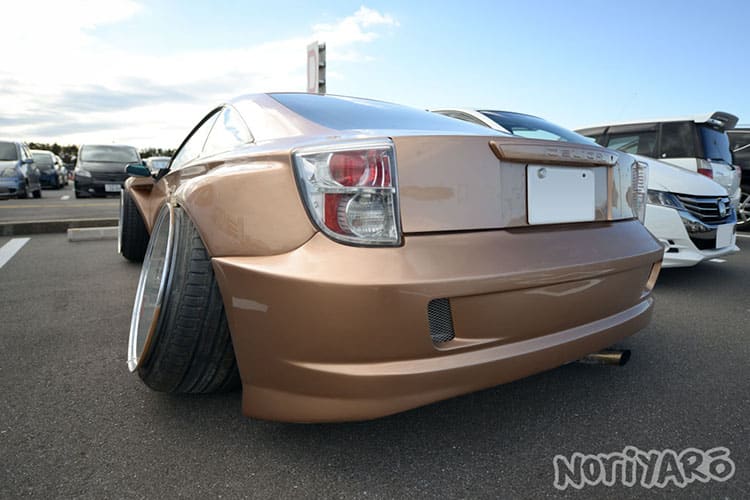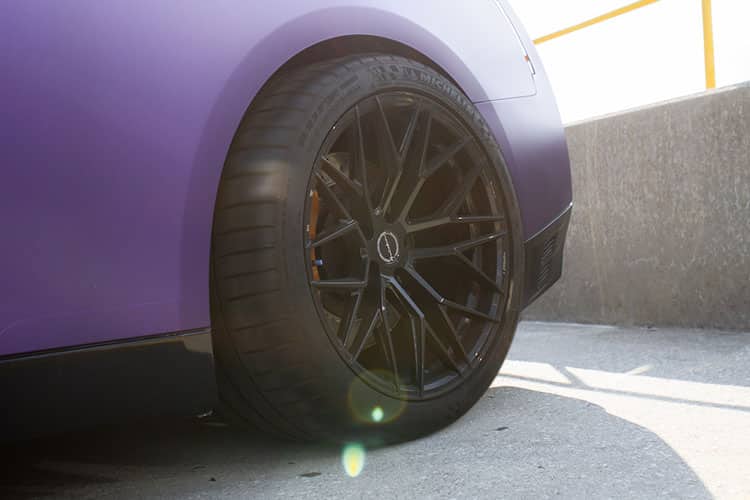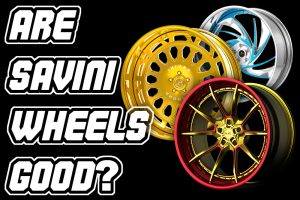What Are Stretched Tires? The Ultimate Guide to Tyre Stretching
If you’ve been involved in the car modifying world at all within the last few years, you will definitely have come across the concept of stretched tyres.
While some people consider this mod essential, others think it’s stupid.
What exactly are stretched tires and why do people do it?
In this post, I’m going to explain everything you need to know about stretching tires.
One thing I want to make clear though before we start: Despite anything written in this post, I am not responsible for anything you choose to do with your car, including running stretched tires. If you decide to do so and it causes damage, injury or harm, do not come back and blame me. I am simply giving you information.
What Are Stretched Tyres?
A “stretched tire” is a term used to describe a tire that has been mounted onto a rim that is wider than it was designed for. It results in the sidewalls of the tire sitting at an angle, with the edges of the wheel poking out.
Here is an example.
This is a normal (not “stretched”) tire:
And here is a stretched tire:
Stretching tires generally done in order to fit wider wheels on a car that would otherwise not be able to fit them, as stretching the tires allows you to get the tire under the fenders while running the wide wheels and getting the wheel to sit either flush with the fender or poke out. It’s very popular with the “stance” scene and in drifting circles.
The origins of stretched tires are constantly debated, with some stories claiming it started in Germany or other parts of Europe where the law stated the tire tread had to be within the fenders.
Other stories claim it started in Japan decades ago, and there are images of Japanese cars from around the 80s running stretched tires.
In any case, stretched tires are incredibly popular worldwide and you will see many cars at shows and meets that run them.
What is Considered Tire Stretch?
Technically, any tire size that is narrower than the recommended width by the manufacturer for the particular wheel size is a stretched tire.
Let’s take for example 8” wide wheels. Typically the smallest tyre size recommended for 8” wide wheels is 225 by most manufacturers.
Therefore, even fitting a 215 tire would be considered stretch, but usually you will see something like a 205 or a 195, which is not extreme.
On the extreme end I have seem tyres as narrow as 175 being fitted to 8” wide wheels, and that’s the point where I would say you are going too far and risking problems.
Why Do People Stretch Tires?
The overwhelming reason people stretch tires is for the look, usually in order to fit the widest wheel possible on their car.
Stretching tyres onto the wheels allows you to run wide wheels and lower your car while minimizing any rubbing or clearance issues. If you ran a full width tyre on wheels that poke out of the fender, you would generally have serious rubbing even at factory ride height, making it impossible.
As the “stance” and “hellaflush” look has become more and more popular, people have started to run stretched tires just because it’s the thing to do, even if their wheel fitment doesn’t necessarily call for them.
It also allows you to run tires that are slightly cheaper than what the proper sized tire would cost, as tires get more expensive the wider you go.
There are arguably some mild performance benefits to stretched tires which I will cover shortly.
Is Tire Stretch Safe?
Generally speaking, yes. But it depends how extreme you go.
Despite the fact that you will constantly hear about how unsafe tire stretching is, the fact is there are very few cases of anything dangerous actually happening as a result of stretched tires, even in the case of extreme stretch.
Now, yes, a stretched tire will always be more of a risk than a tire that isn’t stretched, simply for the fact that you are making the tire do something it wasn’t designed to do.
But the sheer rarity of anything actually happening over decades of people running stretched tires proves that it is nowhere near as dangerous as people claim.
To add to that, many drifters including professional teams run stretched tyres on their cars and have no issues.
Now, if you go absolutely extreme with it, yes you are likely to face problems such as the risk of debeading or air escaping.
Here is an example of what I mean by extreme:

Risks & Downsides Of Stretching Tires
Now, with the above said, there are definitely some risks and downsides to running stretched tires as opposed to normally fitting tires.
Debeading & Losing Air
For starters, a stretched tire is more likely to debead or lose air due to the lack of sealing incorrectly. However, this is generally only an issue if you go completely overboard like the car above. If you are only a size or two smaller than normal, you’ll be perfectly fine.
Less Curb Protection
Another downside is that your wheels will have less protection and are more likely to get damaged if you hit a curb. However, if you have nice wheels, you should be avoiding curbs anyway. Just bear this in mind and be extra careful when parking (and don’t let other people drive your car).
Tire Wear
Stretched tires also tend to wear out faster than normal and will do so in an uneven manner, usually with more heavy wear on the outsides of the tire. When combined with camber from lowering the car, you will find that the insides of the tires tend to wear out quite quickly.
Harsher Ride
Due to the extra stiffness of the sidewalls and the higher tire pressures you need to run, ride comfort is going to suffer, and you will feel bumps more than with regular tires. Be prepared for this if the car is a daily driver or you take long trips.
Insurance Could Be Voided
Insurance companies are known for finding any excuse for not paying out, and if they see that your car has excessively stretched tires, you could risk having your insurance voided.
It is probably best to check with them and at least know what risks you are taking so you know what you are dealing with.
Are Stretched Tyres Legal?
The next big question is are stretched tires actually legal?
This is actually difficult to answer as very few places actually have specific laws stating what tires you can run on what wheel sizes, making it a “grey area” issue.
You’ll find that you are largely subject to the whims of the inspection shop you use or the police in the area as to whether or not they take an issue with it.
In some countries, the law states that you can fit tyres only to the wheel sizes stated by the manufacturer. Most tyre manufacturer will have sizing sheets that tell you what size wheels their tires are for.
Realistically, if the stretch is not too wild, you will more than likely get away with it. Just make sure to check the laws in your area to know what you are dealing with.
Are There Any Performance Benefits to Stretching Tyres?
There are arguably some performance benefits to running a slightly stretched tire.
A slight stretch on the tire will result in the sidewall being stiffer, which will give the tread a more flat profile resulting in more steering response. However, this can also cause loss of grip to be much more sudden, as there is no flex in the tyre to compensate.
Because most people run stretched tyres that are skinner than what they could run with a normal setup, any benefits this brings gets negated by the fact that they have a smaller contact patch on the road, which combined with the extra weight of the wider wheels, just results on loss of performance.
Any performance benefits would only come from using the tyre size you would be anyway, and the wheel being slighter wider to give the tire a little bit of a stretch (say up to an inch over normal).
Any more than that and you won’t be getting any extra benefits but would just increase the risk of something going wrong as well as actually decrease performance due to the extra wheel weight.
However, if looks are your priority then this won’t really matter that much.
Things to Keep in Mind When Stretching Tires
If you have decided to go with a stretched tire setup, there are a couple of things to keep in mind.
Different tyres run wider than others
If you have decided on a wheel width and tire combo you want to go for, keep in mind that different tire brands run wider than others.
What this means is one brand’s 225 tire can actually be the same width as another brand’s 215 or even a 205.
This is incredible important to know if you are trying to get the perfect fitment and millimeters matter.
It’s always a good idea to do a bit of research on the tires you are looking at and try to get information on what their true width is. You can usually find this by doing a quick Google search, or you could always go to the tire shop and measure them.
Tyrestretch.com is an excellent resource for comparing different tyre fitments and brands.
Keep Tire Pressure High
When running stretched tires you will want to keep the tire pressure higher than normal without exceeding the maximum that the tire is rated for.
This is because the tire relies on the tire pressure to remain seated on the bead, and any play or flex in the sidewall could cause it to debead. Often even normal tire pressure won’t be enough to make sure it won’t debead.
Stretched Tires Will Debead Under Low Pressure
Similar to the point above, low tire pressure is likely to result in debeading. This is a problem if you have an issue on the side of the road and run into a flat tire. There is going to be almost no way for you to fix that there like you might be able to with normal tires and an air compressor.
So be prepared that if something happens on the road, you will need to either have a spare or you will be stranded.
How to Stretch Tires
There are several methods that you can use to stretch the tires onto the wheels.
Now, I would generally recommend taking them to a shop to get the tires mounted, as they will have the proper tools and experience. If you are going to extreme stretch, try and find a shop with experience fitting stretched tires.
However, if you want to know how it’s done, here are a couple of different methods.
Mounting the Tire Normally
If the stretch is only minor and your tires are only one or two sizes narrower than normal, you are most likely going to be able to just fit the tire normally and it should seat fine. However, if that doesn’t work, you’ll probably need to use one of the following methods.
Bead Blaster or a Cheetah
Using a bead blaster, otherwise known as a Cheetah (a popular brand of bead blaster) is one of the easiest ways to fit stretched tires.
What this tool does is it fills the tank with compressed air, you fit the nozzle into the gap between the tire and the rim, and it blasts a bunch of air in there to try and force the tire to seat on the bead.
Depending on how extreme the stretch is, it might take a couple of goes, but generally this tool will get it done.
Most decent tire shops should have one of these, which is why it’s a good idea to go to them.
Lighter Fluid and Lighter
Another method to force the tyres to seat is to use lighter fluid or other flammable fluid.
What you do is you spray the fluid around the edge of the tire and inside it, and then light it.
What this will do is rapidly expand the air inside the tire due to the heat, forcing the sidewalls outwards and ideally onto the bead where they will seat. It will also put out the fire.
This method is probably not a good idea if you like your eyebrows and you risk causing damage to your wheels and tires. But people have used it with success to mount tires.
Ratchet Straps
Ratchet straps can be another way to help force the sidewalls out a little bit to get them to seat.
What you do is put the ratchet strap around the tire tread in the center and tighten it up. This will bring the middle of the tyre inwards and force the sidewalls out, giving you the few extra centimeters you might need to get it to seat.
This probably won’t work for extreme stretching, but for mild stretches this often works well.
When You Should Not Stretch Tires
There are definitely instances where stretching tires is not a great idea.
Performance & Track Use
If you intend to use the car for any sort of high performance driving or track days, tire stretch is generally not a good idea.
Sure, a mild stretch of 1-2 sizes will be fine, but anything beyond that and you are risking a failure due to the extra load and stress of taking corners at high speed.
The last thing you want is for a tyre to debead on the track, which can cause you to spin out and hit a wall or potentially someone else.
The other side of that is you are also going to hinder your performance with stretched tires, since you will want to run as wide tires as possible to maximize grip.
If you really want to run stretched tyres on the street or for show, get another set of wheels with wider tires for track use.
Conclusion – Should You Stretch Your Tires?
If you have a wheel fitment that you are set on and the car is going to be used for street use or shows, then stretched tyres will generally be fine unless you get ridiculous with it.
If you are planning to use the car for track days or other high performance driving, anything beyond a very slight stretch is not a good idea and is best avoided both for safety and performance reasons.
- BC Racing BR Series VS Tein Flex Z Coilovers - April 15, 2024
- The Pros and Cons of Shock Body Vs Spring Perch Coilover Height Adjustment - April 13, 2024
- Monotube Vs Twin Tube Shocks: The Ultimate Guide - April 11, 2024









